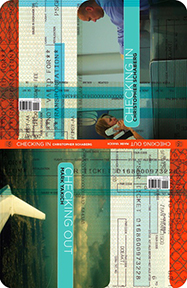He was slim and well-dressed with a nice haircut, not too short, not too long. He wore a black tailored jacket and well-made jeans. His black leather shoes showed no sign of the slush outside the airport. He could have stepped off the pages of an Eddie Bauer catalogue.
But he had something he shouldn’t have had.
He mopped his face with a white linen handkerchief as he put his shoes back on, and I wondered if he was sick. He didn’t look sick. His face was tanned with no sheen of perspiration. I’d never seen a man perspire so politely. His handkerchief was the size of a large dinner napkin with embroidered edges. I didn’t know anyone other than my father still used them.
I had to search his belongings—two Apple notebook computers, one purple and one green, a black leather satchel for compact electronics, a shopping bag full of gifts, and a quart-sized bag of small toiletry items of the type one would collect from hotel rooms. From the looks of that assortment, he’d been around the world, and as he patted his forehead dry, I wondered what else he’d collected in his travels.
The suspicious item was a bottle of water. It was from Neiman Marcus and it wasn’t plastic. It was sturdy cardboard of the type cartons of milk are made out of. The only plastic on it was the screw-on lid like they put on cartons of half and half. It was quart sized. Too big.
Who buys fancy bottles of Neiman Marcus water? Maybe a better question would be why aren’t all water bottles made of this material? Maybe a better question is why do we continue to allow Nestle to siphon water out of the Great Lakes aquifer to ship around the world in single-use plastic bottles that end up in landfills and waterways and the ocean where there is a growing plastic dead zone the size of Greenland? Nestle has diversified into something more profitable than candy bars, but at least they were edible.
But back to my traveler. He was polite about my having to throw away the eco bottle of water (though I wished there had been a way to put it in a display case). He shrugged and mopped his face again, then slipped his belt back through the loops on his jeans, his watch on his wrist, and patted his forehead dry. With each step of putting himself back together he had to wipe his face, and he was well put together.
He dropped his bag of toiletries into the large shopping bag of gifts, wiped his face one last time and put his handkerchief in the pocket of his jacket. He threw a laptop bag over each shoulder and went off to find his gate. I wanted to strip off my uniform and follow him. But I had a job to do, within the auspices of the security theater, a job and a post. I changed my gloves and watched him melt into the throng.
But he stayed with me, a standout midst the hundreds who navigate the roped-off chute in a checkpoint, relinquishing their belongings to scrutiny until given the nod—the dismissive gesture—that it’s okay to reclaim that which they held close. They put themselves back together thinking to leave with their tightly held secrets intact only to end up in a stranger’s story, the indelible impression made at a checkpoint.
Yvonne Osborne lives and writes in the thumb of Michigan, with more time for both since retiring from TSA. Her short stories and poems have appeared in the Great Lakes Review, Midwest Review, Slippery Elm Literary Journal, and elsewhere.






